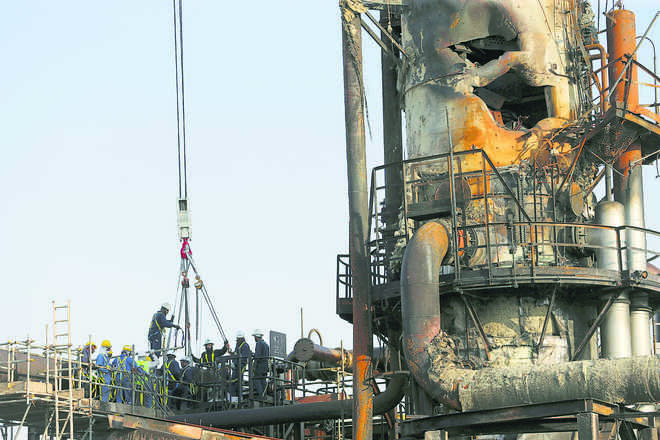
Vulnerable: The Saudi regime can’t defend itself despite a military budget of $68 bn.
Maj Gen Ashok K Mehta (retd)
Military commentator
ON September 14, I was in Muscat (Oman) when the Abqaiq refinery and the Khurais oilfield in Saudi Arabia were struck by drones/missiles that reduced Saudi Aramco’s daily oil production by half. One week later, I returned to Muscat to take stock of the devastating aerial strikes that sent oil prices soaring for major importers of Saudi light crude like Japan, South Korea, China and India and assess its strategic impact in the region. In February 2012, I had attended the annual strategic conference at the Interdisciplinary Centre, Herzliya (Israel), where a terrorist strike on oil facilities in Abqaiq was simulated and counter-measures recommended, which obviously went unheeded.
The geography of the region, viewed from Oman, is breathtaking: the Strait of Hormuz sits at the north-western edge of the Gulf of Oman as it enters the Persian Gulf that divides, rather sandwiches Saudi Arabia between Iran to the north and Yemen to the south. The United Arab Emirates, Qatar and Bahrain girdle the western reaches of the Persian Gulf. The rest of the Middle East — Iraq, Syria, Jordan and Israel — straddles the mighty Euphrates river and the Mediterranean Sea. The Hormuz Strait is a choke point for the movement of oil tankers and shipping in the Persian Gulf via the Gulf of Oman into the Arabian Sea, accounting for 20 per cent of the world’s oil.
Iran-backed Houthi rebels claimed the September 14 aerial strikes with a swarm of 17 missiles and drones that dodged the Saudi air defence network and knocked out 5 per cent of the world’s oil supply of 5.7 million barrels of crude a day. This was a big blow for Saudi Aramco just when Prince Abdulaziz bin Salman, son of King Salman and older half-brother of Prince Mohammad bin Salman, had taken over as Energy Minister, the first time any royal had taken charge of the country’s crown jewels. Aramco claims it has restored half of the lost output and hopes for full restoration by October 14. The stunning success of the not-unexpected precision strikes has unnerved the Saudis, their US allies and other Gulf monarchies in the region. They have unanimously blamed Iran for an act of war, though President Trump has not named the country he despises the most. Saudi Foreign Minister Adel al Jubeir confirmed the source of the attack as ‘not from Yemen but from the north’. Meanwhile, Houthi rebels, in an act of magnanimity, announced a halt to all attacks — drones, missiles and other means — in Saudi Arabia as part of a peace initiative five years after capturing Yemen’s capital Sanaa.
Mark Esper, US Defence Secretary, had immediately ordered additional deployment of US troops in Saudi Arabia, including defensive air and missile systems. Trump took to Twitter to declare (on September 14) that our response is “locked and loaded” but “under what terms we will proceed to protect the Saudis, we will have to work out,” adding that “we’d like to avoid war.” Trump’s last five words summed up the US policy on the aerial strikes and the limits to US power. The Trump doctrine, in essence, amounts to bluff and bluster. On May 4, there were four unclaimed attacks on tankers — two Saudi, one Norwegian and one Emirati — transiting the Strait of Hormuz. There was no US response despite noises in the White House that Iran was behind the attacks. Similarly, in June, two more oil tankers were attacked by suspected Iranian patrol boats. Also in June, a $130-million US drone, Global Hawk, was downed over Iran. In July, Iran seized a British ship when British marines tried to stop an Iranian oil tanker. The US was conspicuously inactive during these depredations except in ratcheting up sanctions against Iran and its leaders.
Meanwhile, after Tehran’s latest alleged act of war, Commander of the Iranian Revolutionary Guard (IRG), Gen Hossein Salami, warned that any country that attacks Iran will become the main battlefield. Tehran displayed remnants of the RQ4-Global Hawk drone that was downed in June, the RQ170 Sentinel drone captured intact in 2011 and the Khordad3 air defence battery which had shot down the RQ4. In addition to threats of retaliation and cyberattacks, the US upped the ante with still new sanctions on Iran and targeting a critical funding mechanism that Iran uses to finance its terrorists including the Qods force — its foreign operational arm. Tehran said US cumulative sanctions would block Iranian access to food and medicine and denied that the cyberattacks on September 14 had disrupted its oil flow.
What are the lessons from the lethal strikes on Saudi oil facilities in 2019 that were forecast and war-gamed in 2012? That sanctions alone will not alter the Iranian regime’s behaviour. The failure of a kinetic response in May/June has emboldened the IRG to step up attacks. In case of US punitive strikes — once evidence is available that the source is Iran — Tehran will hit back at Saudi Arabia, Bahrain, the UAE and target US troops in Syria and Afghanistan. Clearly, the Saudi regime cannot defend itself despite a massive military budget of $68 billion (more than India’s) and the deployment of US Patriot3 and THAAD air defence systems. Ironically, Russia jumped in, offering its S400 ordered by Turkey, China and India.
On September 25, President Rouhani was unrepentant and defiant at the UN even as a US-led international group to protect navigation in the Gulf was revamped. Gen Joseph Dunford, Chief of Joint Chiefs of Staff, has said: “All options have been presented to Commander-in-Chief Trump,” adding that “it is a political judgement not for the military to decide.” Strategic choices are located between inaction and escalation. For Trump, in testing times, discretion seems to be the better part of valour.



























